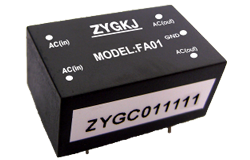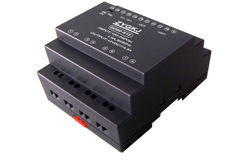նորություններ
Design and Analysis of a Bidirectional DC-DC Converter for Power Electronics Applications
Հեղինակ՝ ZYG Power Module Time: 2023-6-19
Introduction:
Power electronics has become an integral part of many electrical systems. It is used to manage power, convert power from one form to another, and distribute power. One of the most commonly used power electronics devices is the DC-DC converter. A DC-DC converter is an electronic circuit that converts a DC voltage level from one level to another. In this paper, we will discuss the design and analysis of a bidirectional DC-DC converter that can be used in power electronics applications.
Design:
The bidirectional DC-DC converter consists of two parts: a buck converter and a boost converter. The buck converter is used to step down the input voltage, and the boost converter is used to step up the output voltage. The input voltage can be either positive or negative, and the output voltage can also be either positive or negative.
To design the bidirectional DC-DC converter, the first step is to determine the specifications of the converter. The input voltage range should be between -30V to +30V, and the output voltage range should be between -15V to +15V. The output current should be 2A, and the switching frequency should be 20kHz.
The next step is to select the components for the converter. The components used in the buck converter are an inductor, a MOSFET, a diode, and a capacitor. The components used in the boost converter are an inductor, a MOSFET, a diode, and a capacitor. The inductors and capacitors are selected based on the current and voltage requirements. The MOSFETs and diodes are selected based on their current and voltage ratings.
The third step is to calculate the values of the components. The inductor values are calculated using the following formula:
L = (Vin – Vout) x Ton / (Vout x Iout x fs)
where L is the inductance, Vin is the input voltage, Vout is the output voltage, Ton is the on-time of the MOSFET, Iout is the output current, and fs is the switching frequency.
The capacitor values are calculated using the following formula:
C = Iout x Ton / (ΔV x fs x Vout)
where C is the capacitance, Iout is the output current, Ton is the on-time of the MOSFET, ΔV is the ripple voltage, fs is the switching frequency, and Vout is the output voltage.
The fourth step is to simulate the circuit using a simulation tool such as LTspice. The simulation is used to verify the circuit design and to optimize the component values. The simulation results are used to modify the component values if necessary.

Analysis:
The bidirectional DC-DC converter is analyzed based on its efficiency, voltage regulation, and transient response. The efficiency of the converter is calculated using the following formula:
Efficiency = Pout / Pin
where Pout is the output power and Pin is the input power.
The voltage regulation of the converter is analyzed by measuring the output voltage under different load conditions. The voltage should remain within the specified range under all load conditions.
The transient response of the converter is analyzed by measuring the output voltage under sudden changes in load or input voltage. The output voltage should respond quickly to changes in load or input voltage.
Conclusion:
The bidirectional DC-DC converter is a useful device for power electronics applications. It can be used to step up or step down the voltage and can be used in both positive and negative voltage applications. The design and analysis of the converter require careful consideration of the component values and the simulation results. The efficiency, voltage regulation, and transient response of the converter are key factors in its performance. The bidirectional DC-DC converter can be used in various applications such as battery charging, renewable energy systems, and electric vehicles.
Նախորդը: Medical Power Series: Empowering Healthcare Professionals with Knowledge and Skills
Հաջորդ: SM Series AC DC Power Supply
համապատասխան տեղեկատվություն
-
2023-7-5
Introducing the DM Series DC DC Power Supply: Unleashing Efficient and Reliable Power Solutions
In today's fast-paced and technology-driven world, the demand for efficient and reliable power solutions has never been more critical. From telecommunications to renewable energy systems, industries rely heavily on power supplies that can deliver uninterrupted and optimal performance. That's where the DM Series DC DC Power Supply comes into play, offering cutting-edge technology and unmatched reliability. The DM Series DC DC Power Supply is designed to meet the stringent power requirements of various applications, making it the go-to choice for professionals seeking high-quality power solutions. With its superior efficiency and reliability, this power supply ensures uninterrupted operations and enhances the performance of critical systems. One of the standout features of the DM Series is its high conversion efficiency. By employing...
Մանրամասնորեն -
2022-9-6
Ամենատարածված մեծածախ DC-DC փոխարկիչները
Ի՞նչ է DC-DC փոխարկիչը: DC-DC փոխարկիչը սարք է, որը փոխակերպում է ուղղակի հոսանքը (DC) մեկ լարման մակարդակից մյուսը: Այն կարող է օգտագործվել լարումը բարձր մակարդակից ցածր մակարդակի իջեցնելու կամ լարումը ցածր մակարդակից բարձր մակարդակի բարձրացնելու համար: DC-DC փոխարկիչները օգտագործվում են մի շարք ծրագրերում, ներառյալ էլեկտրոնիկա, տրանսպորտային միջոցներ և վերականգնվող էներգիայի համակարգեր: Որո՞նք են DC-DC փոխարկիչների տարբեր տեսակները: Կան բազմաթիվ տարբեր տեսակի DC-DC փոխարկիչներ, որոնցից յուրաքանչյուրն ունի իր առավելություններն ու թերությունները: Ավելի տարածված տեսակներից մի քանիսը ներառում են բաք, խթանող և բաք-բոստ փոխարկիչներ: Buck փոխարկիչները ամենատարածված տեսակն են և օգտագործվում են DC ազդանշանների լարումը իջեցնելու համար:
Մանրամասնորեն -
2023-11-3
High Voltage Power Supply Module: Empowering Electrical Systems with Elevated Energy Levels
Introduction: In today's technologically advanced world, the demand for high voltage power supply modules has been increasing exponentially. These modules play a critical role in various industries, providing the necessary power to drive electrical systems with elevated energy levels. This article aims to explore the importance of high voltage power supply modules and their impact on empowering electrical systems. Understanding High Voltage Power Supply Modules: High voltage power supply modules are sophisticated electronic devices designed to convert and amplify voltage levels to meet the requirements of specific electrical systems. Their primary function is to take input voltage from a source and supply high voltage output to power various devices. These modules are commonly used in industries such as telecommunication, medical...
Մանրամասնորեն -
2023-5-26
AC DC Converter Module: Streamlining Power Conversion for Enhanced Efficiency
The AC DC converter module is an essential component in modern electrical systems. It efficiently converts alternating current (AC) to direct current (DC) to power electronic devices. This process is vital because many portable devices rely on batteries that require DC power. The converter helps to streamline the power conversion process, ensuring that devices receive reliable, regulated, and stable power. The converter module consists of several components, including a transformer, rectifier, and filter. The transformer steps down the voltage from the AC power source, while the rectifier converts the AC to DC power. The filter then smoothens the output, removing any unwanted noise or ripple. In addition, the converter module can be designed to provide various output voltage levels, making...
Մանրամասնորեն -
2023-4-12
How to Build an AC-DC Converter
An AC-DC converter, also known as a rectifier, is an electrical device that converts alternating current (AC) power to direct current (DC) power. This conversion process is essential for many electronic devices, as they require DC power to function properly. In this article, we will discuss the basic principles of building an AC-DC converter. The first step in building an AC-DC converter is to choose the right components. The most important components of an AC-DC converter are a transformer, a diode bridge, and a filter capacitor. The transformer is used to step down the AC voltage to a lower voltage that can be rectified. The diode bridge is used to rectify the AC voltage, which means that it converts the...
Մանրամասնորեն -
2023-7-14
24V AC to DC Converter: Efficient Power Conversion for Electronic Devices
Introduction In today's world, electronic devices have become an integral part of our lives. From smartphones to laptops, we rely on these gadgets for communication, work, and entertainment. However, these devices require a stable and reliable power source to function properly. This is where a 24V AC to DC converter comes into play. In this article, we will explore the benefits and importance of efficient power conversion for electronic devices. What is a 24V AC to DC Converter? A 24V AC to DC converter is an electrical device that converts alternating current (AC) to direct current (DC) with a voltage output of 24 volts. This conversion is necessary because most electronic devices operate on DC power. The converter ensures that...
Մանրամասնորեն


















